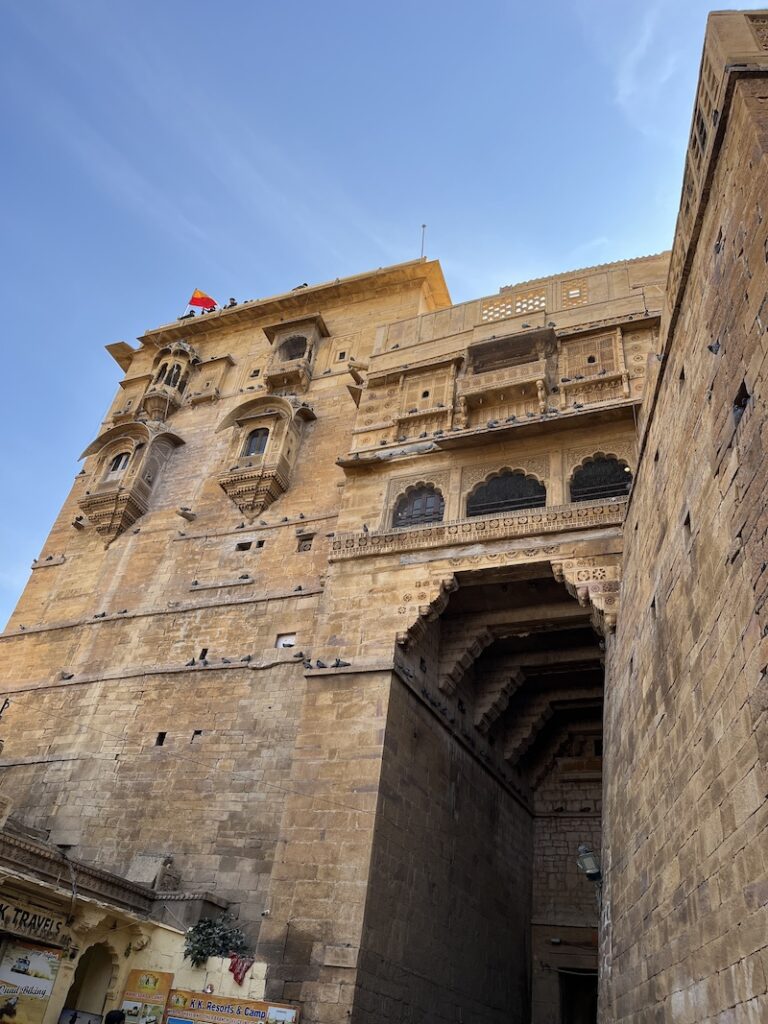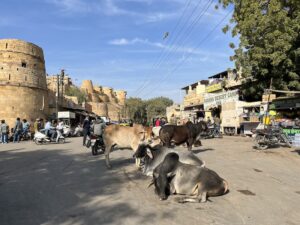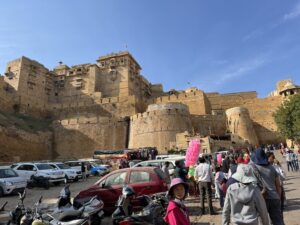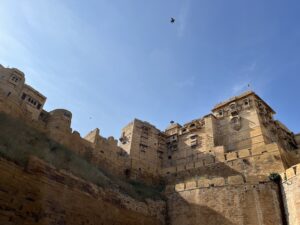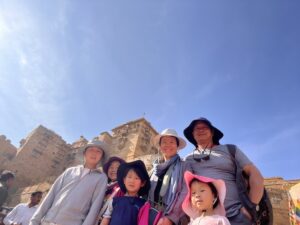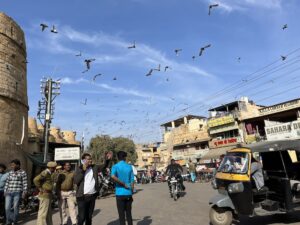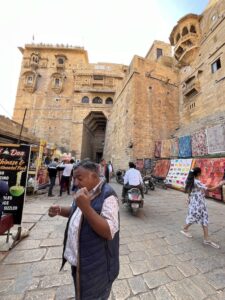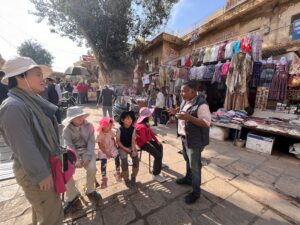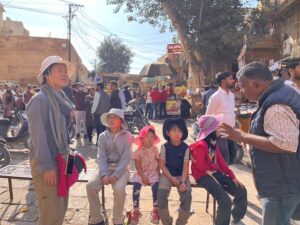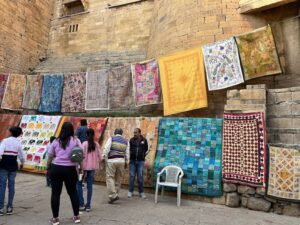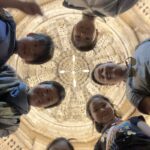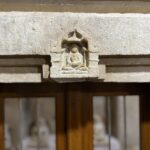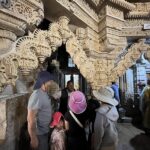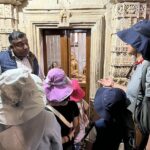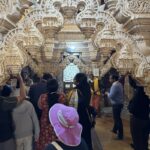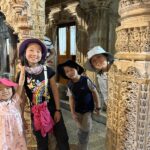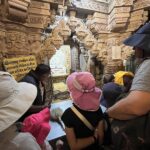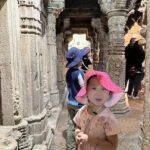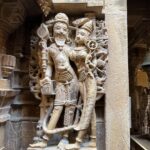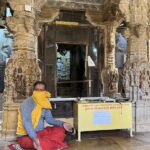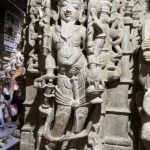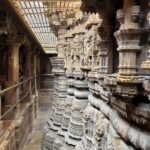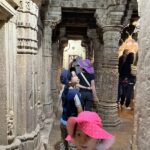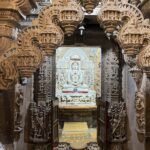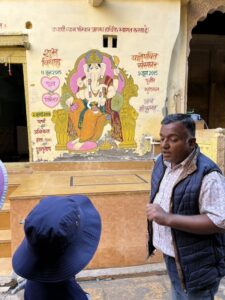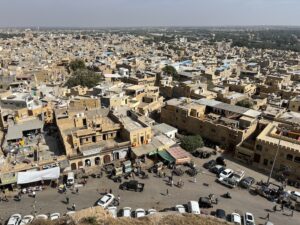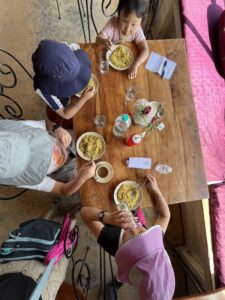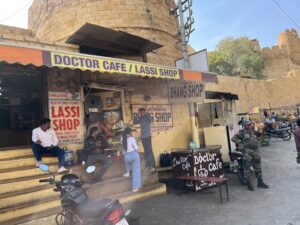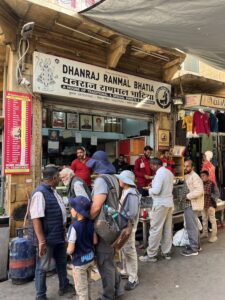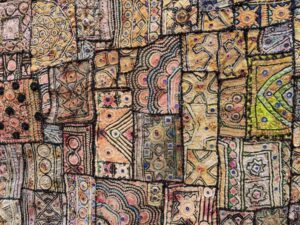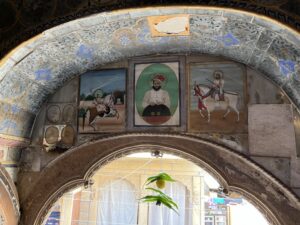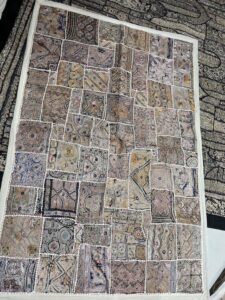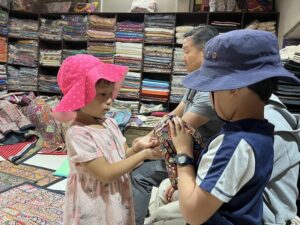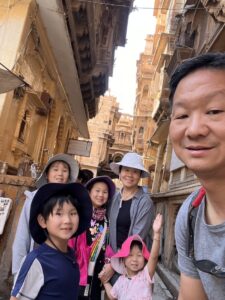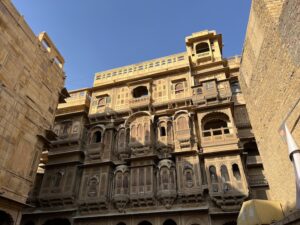Of all the forts in India, Jaisalmer Fort is the only “living” fort, meaning Jaisalmer Fort has been continuously inhabited since its construction by Rawal Jaisal in 1156. This was intriguing to us as all of the other forts we have visited were more like historic sights preserved for tourism rather than living cities. The fort is home to about 5,000 residents, mostly descendents of old Brahmin and Rajput families that have inhabited the fort for generations.
From a distance, we could spot Jaisalmer Fort, rising up from a rocky hill in the Thar Desert. Built of yellow sandstone, it almost blended into the desert terrain. The way that it towered above the city and dominated the landscape reminded me of Jodhpur’s Merengarh Fort. It didn’t just look huge, it was truly immense with more than a quarter of the town’s population once living within its walls.
Despite the kids’ protests, we hired a guide to take us through the maze-like alleys of the Fort and reveal her best secrets to us. We entered the fort from the Suarj Pol, one of the four entry gates. Inside the fort, the streets were bursting with life. Vendors for handicrafts, trinkets and sourvenirs lined the streets along with snack carts, shops and restaurants.
Jaisalmer Fort was established by Rawal Jaisal in 1156 AD. Legend has it that a sage named Eesul told Jaisal that the god Krishna had prophesized that one day, a prince would establish a great kingdom on this hill. And so Jaisal built a mud structure on the hill and named his new kingdom Jaisalmer.
Over the years, Jaisalmer fended off attackers and withstood wars to remain one of the few forts that remained unconquered throughout history. Eventually, it mushroomed to become a 250 foot tall fort protected by 30 feet of walls and 99 bastions, 92 of which were built between 1633 and 1647. Inside the thick walls contained a thriving city with palaces, havelis, Hindu and Jain temples, homes and markets.
Its importance and wealth came from its strategic location along the Silk Route, the 2000-year old trade route connecting China to Turkey through India and Central Asia. Once upon a time, Jaisalmer was a stop for merchants and travelers carrying spices, silks, tapestries and other precious goods, who preferred to take their chances in the dry desert sands of the Thar Desert rather than the snowy Pamir Mountains of what is now Tajikstan.
One of the most important sights in the fort are the famous Jain Temples. During our travels in Rajasthan, we learned that Hinduism and Islam played a central role in the architecture and lives of the people. But this was the first we were hearing about Jainism in a historical context. In modern India, Jains form less than 1 % of the population of India and live primarily in Maharashtra and Rajasthan. As a small segment of the population, Jains are viewed by other Indians as being wealthy and in fact, the vast majority of Jains fall into India’s top income group. Historically, the choices that led to their wealth were rooted in their belief in non-violence which deterred them from work in farming and anything to do with animals. Instead, they earned a living from trade and business.
As a religion, Jainism is one of the three ancient religions that originated in India, the other two being Hinduism (including Sikhism) and Buddhism. Some parts of the Jain religion resemble Hinduism and Buddhism, for example, they believe in enlightenment as the highest ideal and that after death, beings will be reincarnated. Unique to Jainism is that their belief system is founded on the principle of non-violence and avoiding harm to all living things including plants, animals, insects and micro-organisms. Because of their beliefs, Jains are strict vegetarians and even consuming root vegetables are prohibited because it requires killing the plant, compared to leafy greens and fruit that are plucked or picked but allow the plant or tree to continue living. Jain monks will go to an even greater extreme to avoid harming living things by first sweeping their path to avoid accidentally stepping on and killing ants or insects and covering their mouth so microorganisms in the air will not be disturbed or unintentionally killed.
The story of Rawal Jaisel continues here. Rawal Jaisel had amibitions to build a great kingdom. While he posessed land, he did not possess great wealth. When he first established Jaisalmer, with the limited resources he had, he could only build a simple fort of mud. To build a real kingdom, he needed capital. Jaisel found the perfect partner in the Jain community. The Jains were ridiculously wealthy merchants who controlled the silk route.
Thought wealthy, their gold and riches did not make their temples immune to looting and attacks. During an attack on the old capital of Lodharva, the Mughals had destroyed a sacred Jain temple. They were in search a strong king who could protect their temples. So, the Jains and Rawal Jaisal struck a deal. The Jains agreed to provide the capital for Jaisalmer Fort if King Jaisal agreed to keep the Jain temples safe within the walls of the fort. The seven Jain temples in the fort were built between the 12th and 15th centuries. Over the next centuries, during times of war and instability, in particular after the formation of Pakistsan in 1947, the Jain community transported many of their most precious relics and scriptures to the temples in Jaisalmer Fort for safe keeping. These priceless items are kept in underground vaults beneath the temples.
We visited one of the seven Jain temples in the fort. Jainism is a nontheistic religion, meaning they do not worship a god or gods. They worship 24 Jinas, or Tirthankaras, spiritual leaders who achieved enlightenment thus successfully liberated from the cycle of rebirth. Each temple is devoted to one of the Tirthankaras.
The Chandraprabhu Jain Temple was built in 1509 and dedicated to the 8th Tirthankara Chandaprabhu. This was our first time inside a Jain temple. The intricacy of the carvings covering the entire temple was unbelievable. There were carvings of devas, mortal creatures with special god-like powers, on pillars, walls and even on the ceilings. We immediately noticed the visual similarities between Jain and Buddhist iconography. There was a Buddha-like figure replicated and displayed in the center of the temple. Buddhists worship Buddha whereas Jains worship the 24 Tirthankaras. The Buddha-like figure in this temple was the 8th Tirthankara. Jainism and Buddhism more or less developed around the same time period and in the same geographic area, resulting in similarities in their religious ideas and visual expressions.
The kids were very curious about the differences between Jainism, Hinduism, Sikhism and Buddhism and our guide tried his best to explain the differences in simple terms.
The guide led us through the fort, leaving the bustling tourist areas behind. We passed by some ordinary neighborhoods where people were going about their daily lives. We saw some colorful wall art. Far from graffiti, these were open wedding invitations welcoming everyone in the neighborhood to join in the festive celebrations. Festivities would be held in the home of the family and spill out onto the patio and out into the street.
We stopped at a café on higher ground where we enjoyed expansive views of the surrounding city of Jaisalmer. When it was first constructed, almost all of the residents lived within the walls of the fort. Over time, life expanded outside of the fort. The view that we saw from the café was built mostly over the last few decades and now it looks like any other sprawling city in the desert. It was past lunchtime so we ordered a quick bite to eat. What better than some Maggi noodles.
We wandered through the commercial areas crammed with shops, restaurants and businesses. The tourist shops selling burgers, pizza and coffee were mixed together with the local shops selling produce, plumbing parts and repair services.
It was fascinating just to meander through the streets of the fort. There was always something interesting to look at. We reached our next destination, an old haveli called Nathmal Ki Haveli. It is one of many grand havelis that have seen better days. Some of the havelis in the fort are 500 years old while most were built in the 19th century.
Nathmal Ji Ki Haveli was built in the late 19th century and was commissioned by the then ruler of Jaisalmer and served as the residence of the prime minister of Jaisalmer. It was designed and constructed by two brothers named Nathmal and Hathi Singh. The brothers divided the project into the left-side and right-side and each brother worked on half of the house, eventually meeting at the middle. Legend has it that through a little friendly competition and inspiration, they created a Rajasthani masterpiece of a building that appears symmetrical to the eye, but in fact, the left and right side are not the same and feature minute design differences. It took 22 years to complete the haveli.
The haveli is occupied by the descendants of the original owners and we were invited in to have a look around. We walked through a room on the first floor that served as their living room where there was a young boy watching TV. Other rooms and corridors had been converted to what appeared to be a make-shift kitchen and bedroom. The haveli had definitely seen better days, but we could see remnants of the grandeur that must have once graced the home. On the second floor, the owner showed us a room that had hand-painted tiles of flowers in bloom, Rajput warriors preparing for battle and maidens performing traditional dances. The owners had converted another large room to a showroom cum souvenir shop. It was a fascinating juxtaposition of antique portraits of famous ancestors, religious prints and cheap tourist trinkets. There was no obligation to buy but we left a donation to be used for much needed upkeep and maintenance of the haveli.
Before leaving the fort, we were keen to visit a specialty shop selling textile embroidery wall hangings, called mukke, that were created by local women out of existing pieces of clothing. We had seen them in tourist shops throughout the fort and thought they were really beautiful.
The shop we went to was part of a women’s cooperative that helped women from poor communities sell their crafts to tourists. The shop was inside an old haveli and in the main courtyard, there were a few women surrounded by bags of old cloth creating the patchwork mukkes. Just by looking at the patchwork textiles, locals can identify which community the artisan comes from.
As our last stop, we strolled by the famous Patwa havelis, a cluster of five havelis built in the 19th century by the wealthy brocade merchant and jeweler named Guman Singh Patwa, one for each of his five sons. Patwa’s business fell onto hard times and the havelis fell into disrepair. They were taken over by the Archaeological Survey of India in 1974 and underwent extensive restorations. Currently, one of the havelis is operated as a museum and another as a hotel.
In the small lanes near the haveli, vendors were selling tourist trinkets and toys. RY saw a small retractable dagger that he wanted to buy so he could use the parts to make a disguised pen-knife. He mulled over the decision for a while and in the end, decided not to get it. Immediately after we left the fort, he regretted his decision and we would all suffer the consequences of hearing him lament about it for days.
Author
-

Song is the mother of four children. She and her family have stepped away from it all and in September 2023, began traveling the world while homeschooling. Song is an ABC (American born Chinese) and has an undergraduate degree from Cornell and an MBA from Harvard. She is an entrepreneur and an educator. Her hobbies include learning, traveling, reading, cooking and baking, and being with children.

